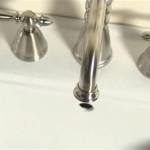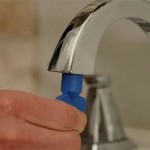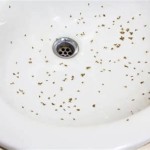Installing a Wall-Mounted Bathroom Sink: A Comprehensive Guide
A wall-mounted bathroom sink offers a sleek, modern aesthetic and can significantly increase floor space, making it a popular choice for contemporary bathroom designs. Unlike traditional pedestal or vanity sinks, a wall-mounted sink is directly attached to the wall, creating a floating effect that enhances the room's overall visual appeal and facilitates easier cleaning. However, installing one requires careful planning, precise measurements, and a thorough understanding of plumbing and wall construction. This article provides a detailed guide to the installation process, covering essential preparations, step-by-step instructions, and important considerations for a successful outcome.
Before embarking on the installation, it is crucial to determine the suitability of the wall for supporting the sink's weight, especially when filled with water. Most wall-mounted sinks require a reinforced wall, often incorporating additional framing or a carrier system, to ensure stability and prevent potential damage. Furthermore, a proper understanding of the existing plumbing configuration is essential for connecting the sink's drain and water supply lines. Ignoring these preliminary assessments can lead to structural issues, leaks, and costly repairs.
Key Point 1: Pre-Installation Planning and Preparation
The success of a wall-mounted sink installation hinges on meticulous planning and preparation. This phase involves assessing the wall's structural integrity, gathering the necessary tools and materials, and understanding the existing plumbing setup. Skipping these steps significantly increases the risk of errors and complications during the actual installation.
First, the structural soundness of the wall must be evaluated. Ideally, the wall should be a solid, load-bearing wall constructed of concrete, brick, or reinforced drywall. If the wall is a standard drywall construction, it is necessary to strengthen it with additional framing or install a wall-mounted sink carrier. A sink carrier is a metal frame that is attached to the wall studs and provides a secure mounting point for the sink. It distributes the weight of the sink evenly across the wall studs, preventing strain on the drywall.
The type of wall also dictates the type of fasteners needed. Concrete or brick walls require specialized anchors designed to grip the masonry. Drywall, even with additional framing, demands strong toggle bolts or similar anchors that can securely attach to the studs behind the drywall. Consult with a building supply professional to determine the most appropriate fasteners for the specific wall type and the weight of the sink.
Next, gather all necessary tools and materials. This includes:
*Wall-mounted sink with mounting hardware
*Sink drain and P-trap
*Water supply lines (hot and cold)
*Shut-off valves (if not already present)
*Drill with appropriate drill bits (for masonry or wood, depending on the wall)
*Level
*Tape measure
*Pencil
*Wrench or adjustable pliers
*Screwdrivers (Phillips and flathead)
*Pipe cutter (if necessary to modify existing pipes)
*Plumber's tape or pipe sealant
*Safety glasses and gloves
*Stud finder (for locating wall studs)
Finally, examine the existing plumbing configuration. Locate the water supply pipes and the drain pipe. Ensure that they are positioned in a way that allows for a seamless connection to the sink. If the pipes need to be relocated or extended, it is advisable to consult a licensed plumber to avoid potential plumbing code violations or leaks. The height of the drain pipe is particularly important, as it will determine the final height of the sink. Standard bathroom sinks are typically mounted at a height of 31 to 36 inches from the floor to the top of the sink basin. However, this height can be adjusted to accommodate the needs of the users.
Key Point 2: The Installation Process: A Step-by-Step Guide
With the pre-installation preparations complete, the actual installation can begin. This involves mounting the sink to the wall, connecting the drain and water supply lines, and testing for leaks. Accuracy and attention to detail are paramount during this phase to ensure a secure and watertight installation.
- Mark the Mounting Points: Using a level and a tape measure, determine the desired height of the sink. Mark the location of the mounting holes on the wall, ensuring they are aligned with the sink's mounting hardware. Use a stud finder to locate the wall studs and position the mounting points on the studs for maximum support. If using a sink carrier, follow the manufacturer's instructions for attaching the carrier to the wall studs.
- Drill Pilot Holes: Using a drill bit appropriate for the wall type, drill pilot holes at the marked locations. For masonry walls, use a masonry drill bit. For drywall walls, use a drill bit slightly smaller than the diameter of the wall anchors. When drilling, exercise caution to avoid damaging any hidden pipes or wires.
- Install Wall Anchors or Sink Carrier: Insert the appropriate wall anchors into the pilot holes. For drywall walls, use toggle bolts or similar heavy-duty anchors. If using a sink carrier, attach the carrier to the wall studs according to the manufacturer's instructions.
- Mount the Sink: Carefully align the sink with the mounting holes and attach it to the wall using the provided mounting hardware. Tighten the screws or bolts securely, but avoid over-tightening, which could damage the sink or the wall. Periodically check the level of the sink during the mounting process to ensure it is perfectly horizontal.
- Connect the Drain: Assemble the sink drain and P-trap according to the manufacturer's instructions. Apply plumber's tape or pipe sealant to the threads of the drain fittings to ensure a watertight seal. Connect the P-trap to the drain pipe in the wall. Ensure that the P-trap is properly aligned to prevent clogs and maintain proper drainage.
- Connect the Water Supply Lines: Attach the water supply lines to the shut-off valves, if present. If shut-off valves are not present, it may be necessary to install them. Apply plumber's tape or pipe sealant to the threads of the water supply fittings. Connect the other ends of the supply lines to the faucet tails on the sink.
- Test for Leaks: Turn on the water supply and check for leaks around the drain fittings, water supply connections, and the sink itself. If leaks are detected, tighten the connections or reapply plumber's tape or pipe sealant as needed. It is crucial to thoroughly check for leaks before concealing the plumbing behind the wall.
Key Point 3: Important Considerations and Potential Challenges
While the above steps provide a general guideline, several factors can influence the complexity of a wall-mounted sink installation. These include the existing plumbing configuration, the type of wall, the weight of the sink, and local building codes. Addressing these considerations proactively can prevent unexpected challenges and ensure a safe and compliant installation.
One of the most common challenges is dealing with existing plumbing. The location of the drain and water supply pipes may not align perfectly with the sink's requirements. In such cases, it may be necessary to modify the pipes, which can involve cutting, extending, or relocating them. This should be done by a licensed plumber to ensure compliance with local plumbing codes and prevent leaks. Incorrectly modifying plumbing can lead to costly repairs and potential water damage.
Another important consideration is the weight of the sink. Wall-mounted sinks can be quite heavy, especially when filled with water. The wall must be strong enough to support this weight without sagging or collapsing. As mentioned earlier, reinforcing the wall with additional framing or installing a sink carrier is often necessary. The type of wall anchors used is also crucial. Using the wrong type of anchors can lead to the sink pulling away from the wall over time, creating a safety hazard.
Finally, it is essential to be aware of local building codes. These codes often specify requirements for plumbing, electrical, and structural work. Failure to comply with these codes can result in fines or require redoing the installation. Before beginning the project, it is advisable to consult with a local building inspector to ensure that the installation meets all applicable codes.
Installing a wall-mounted bathroom sink is a project that requires careful planning, precise execution, and a thorough understanding of plumbing and wall construction. By following the steps outlined in this guide and addressing potential challenges proactively, it is possible to achieve a successful and aesthetically pleasing installation. If unsure about any aspect of the installation, consulting with a licensed plumber or contractor is always recommended.
Pedestal And Wall Mount Bathroom Sinks

Installing A Bathroom Sink Wall Hung Diy Family Handyman

Fitting A Wall Hung Basin In Bathroom Guru

How To Install A Sink Wall Mount 3 Minute Guide

Wall Mount Sink Installation All Step By Instructions

How To Install A Wall Mount Sink And Plumb It Too

Wall Mounted Bathroom Sinks Pros Cons Diy Install Guide

Fitting A Wall Hung Basin On Stud Bathroom Guru

Wall Hung Washbasin Installation Cono Centro And Silenio Kaldewei

How To Install A Wall Mounted Sink Hometips Bathroom Drain
Related Posts







